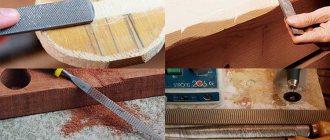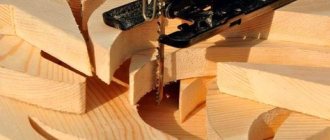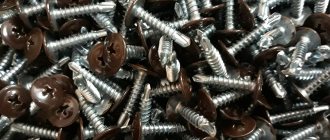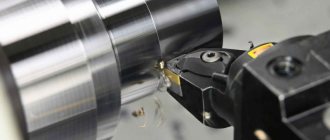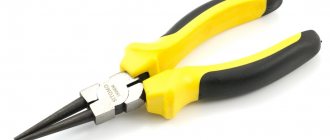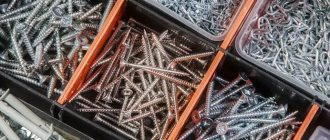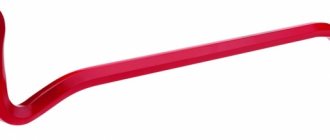Working with metal and wood workpieces is not complete without the use of specialized tools. These include files designed for grinding the surface of materials in order to remove a layer of metal or wood. This is a hand tool that has found its application in various fields and industries, including in the household. Many craftsmen have these devices in their arsenal, but do not know that they are produced in a wide variety. What types of files for metal and wood are there, and how to use them correctly, you will find all this in the form of a detailed analysis in the article.
File - what kind of tool is it and its structural components
Different tools are used to process metal and wood workpieces. The main purpose of files is to grind off the top layer from metal and wooden workpieces. Even children are familiar with the design of this device, since the tool is a metal multi-bladed bar of different shapes with a handle. For the manufacture of the bar, special grades of steel are used - ШХ15 and У10А. These are steels consisting of 1.1-1.25% carbon, that is, with a low carbon content. The outer surface of the metal part has notches through which the surface is ground.
The main structural elements of the device are:
- Steel beam - can have a rectangular, round, triangular shape, on the outer surface of which notches are applied. These notches are cutting edges that are used to grind off the metal layer. The notches form a corrugated surface (multi-blade part), which allows for high precision when processing parts.
- Handle - used to control the tool. Wood or plastic is used for its production (metal handles are very rare). Modern files are equipped with fiberglass handles. The handle is attached to a metal bar through a cone-shaped shank. If the handle fails, it can be replaced, which is one of the most important advantages of files
If you look at the photo of the tool, in addition to the main structural parts, it consists of many auxiliary elements:
- Edges are notches on the working base of the tool. They are the ones who make a file from a piece of metal, which is used to perform a number of different functions.
- Ribs are the sides of the metal base, which also have notches. Using these notches you can saw off workpieces
- The toe is the end or front part of the device. It has a blunt, tapered shape
- The heel is the back part on which there are no notches. The heel connects the blade to the shank
- Shank - a narrowed cone-shaped part through which the handle is attached to the metal part
The simplest design of the tool allows it to be used to solve the following problems:
- Reducing the edges of various parts and workpieces, which is carried out in order to adjust them to the required dimensions
- Removing dirt and rust from the surface of parts and workpieces
- Sharpening of various tools and equipment
- Grinding parts to appropriate roughness levels
- Cutting off workpieces - can be used as a cutting tool
- Making chamfers, splines, radii and grooves
There is one secret that will help every craftsman when it is necessary to obtain a hole of the required diameter. If you don’t have a drill of the required diameter at hand, a round file will help you get the appropriate hole size. To do this, you need to pre-drill a hole of the same diameter as the drill available. After this, using a file, the diameter is increased to the desired size.
The production of files is carried out in compliance with the relevant requirements. These requirements are provided for by GOST 1465-80. The main requirement stipulated by GOST is to ensure high hardness of the metal base of the tool. To achieve high strength parameters, the metal base is subjected to heat treatment without tempering. In this case, a tool hardness corresponding to values of at least 54-58 HRC is achieved.
This is interesting!
A nail file is the closest relative of a carpenter's file. Tools are designed to perform similar actions, but they process different types of materials.
Files
File
— a cutting tool for processing materials using the method of layer-by-layer cutting (filing).
It is a steel strip (blade), on the working surfaces of which a “notch” is created - cutting elements (sharp teeth). A handle is attached to the cone-shaped shank of the file. According to their intended purpose, files are :
File length
— its working part excluding the shank. Size range in (mm): 100, 125, 150, 200, 250, 300, 350.
Cross section of files
: –
flat –
rectangular in cross-section, designed for filing wide surfaces.
They may have a tapered end (toe). There is a notch on the side edges, usually only on one side; – square, triangular
they always have a tapered toe;
– semicircular files combine
Rice
. Files of various cross sections: a - flat (rectangular); b - square; c - triangular; g - round; d - semicircular
Types of notches
: –
single –
applied at an angle of 70° to the longitudinal axis of the file, sometimes at 45°.
It removes wide chips from the material being processed and is designed to produce a surface with a slight roughness; – double (
cross) – is a combination of a single notch and a less deep auxiliary notch, made at an angle to the single one.
The intersection points of these notches break the resulting chips during the filing process. This notch is the main one for metalworker’s files; – double (“oberg”)
- with a rarer (2-3 times) auxiliary notch. Occupies an intermediate position between single and double notches in terms of efficiency and cleanliness of surface treatment.
Notch size
- this is the number of teeth per 1 cm of file blade length. Based on the number of teeth, there are three notch sizes:
- garnish -
the coarsest, has a small number of teeth per 1 cm; - personal -
average, the number of teeth is 1 cm more than the previous one; - velvet -
small, the largest number of teeth per 1 cm.
The same number of teeth per 1 cm, but on files of different lengths, will refer to different notch sizes. For example: 14 teeth per 1 cm with a file length of 200 mm - personal notch, the same number of teeth per 1 cm on a file 300 mm - velvet
. The coarser the notch, the higher the filing speed, but the greater the surface roughness. The service life of the tool depends on the grade of steel, the quality of the cut and heat treatment.
Read also: Landing diameters of saw blades
For the production of domestic files
Two groups of tool steels are used:
File handles
largely determine the convenience and safety of work. They must have sufficient mechanical strength, a reliable fit on the shank and not be destroyed by oils, gasoline, or solvents. For their manufacture use:
- hardwood .
Such handles are reinforced with a metal clip (ring), which protects them from longitudinal splitting. To protect them from rotting and contamination, they are coated with colorless varnish or paint; - plastic - hard
Most often, these handles are ergonomically shaped with a hole for hanging a file during storage.
What types of file shapes are there?
The first thing you should pay attention to when considering files is the variety of their shapes. According to the shape of the working parts, files are of the following types:
- Flat or rectangular
- Round
- Semicircular
- Oval
- Diamond-shaped
- Triangular or trihedral
- Square
Depending on the shape of the tool, it is used to perform the corresponding functions:
- A round file is best suited for finishing holes and also increasing their diameter.
- Triangular devices are used primarily for processing the corners of parts, as well as for sharpening teeth on hacksaws.
- Flat - they are considered the most popular and are used to work with the surfaces of various workpieces
- Semicircular - they are used for boring holes
- Diamond-shaped - used when it is necessary to process teeth, gears and other types of parts
- Square - used for boring holes of complex shapes. With their help you can make a square hole out of a round hole.
The length of the instruments in question varies from 50 to 500 mm. It is necessary to select files by length based on the size of the parts being processed. The larger the surface of the workpiece, the longer the file should be.
What is better to buy
Analysis of sales of online stores showed that the following types of tools are popular in the market of goods and services:
- Flat – designed for processing flat surfaces, as well as areas with internal grooves and having maximum curvature parameters;
- Round – designed for processing rounded, ellipsoidal holes and cuts; wood files also smooth out the end part of the boards;
- Semicircular – universal tools, the configuration of which allows you to perform the work of a round and flat file on wood;
- Rhombic - designed for working with shaped surfaces that may look like gears, sprockets and other intricate parts;
- Triangular – wood files with three planes, designed for leveling different types of surfaces and making shaped cuts.
Advice! When buying wood files, pay attention to both the material used and the ease of holding the file. The tool should not slip out of your hands, be of an awkward shape or too heavy.
What types of files are classified into according to their purpose?
Depending on the scope of application, files are divided into 5 main groups:
- Locksmith
- Machine or belt type
- Special
- Files
- Rasps
Each type of tool has its own characteristics, which are important to take into account in order to ensure high-quality processing of certain workpieces and parts.
- A metalworker's or hand file is the most popular type of working tool used in metalworking work. The notch on the devices has a double appearance, and the size of the teeth must be selected depending on the required quality of processing
- Tools for special purposes are used by craftsmen at enterprises and factories when performing metalworking work. Such instruments differ not only in size, but also in workmanship. With their help, craftsmen eliminate defects remaining after machining. The main requirement for special-purpose files is to withstand prolonged load during their operation.
- Needle files are a smaller type of file, which includes 11 varieties of shape. The notches on smaller models of tools are fine-grained, which allows them to be used for precision or finishing machining of parts.
- Rasps are an enlarged type of file, equipped with large teeth. Such devices are designed to perform rough metal processing
- Machine or belt - a separate group of tools for processing metal and wood, which differs not only in the method of application, but also in design. A band file is sandpaper in the form of a round strip. Such a tape is attached to an electrical device, while performing the corresponding work. Tape devices are an alternative to hand tools, but a number of disadvantages do not allow them to fully replace plumbing tools
It is necessary to choose files based not only on the shape, but also depending on the work being performed. Locksmith tools are universal and are suitable for performing various actions with metal and wooden workpieces.
Technical features of the file
It is important to consider several requirements before purchasing a file. They are as follows:
- Product size. Tool parameters should be selected taking into account the area in which it will be used. For example, to process small iron areas, compact product models will be needed;
- Handle material. Plastic models slip in the hand when pressed for long periods of time. The wooden base is more pleasant to the touch;
- Tip material. For frequent use, it is recommended to select models whose working part is made of steel categories ШХ 15, 13Х, У10А;
- Notch size. The metal part can be made in the form of thin strips, thick ribs or alternating.
If you take these recommendations into account, you will be able to purchase a tool that will meet all the requirements. Compact and miniature products should not be used for processing large parts. To do this, the file size must be at least 15 cm.
Types of notches on tools and what they mean
The size of the notches on files is interconnected with such an important parameter as the length of the working part. Devices with large teeth are used when it is necessary to remove a large layer of metal. After this treatment, the surface becomes rough and therefore requires additional treatment before painting. To remove small amounts of metal, devices with fine notches are used. After carrying out the work with finely cut files, a better surface is obtained.
The notches or blades on the surface of the metal part of the tool come in different types. The most common classification of notches is by appearance. They come in double and single.
- Single - differ in that the lines on the surface of the metal workpiece are applied only in one direction. Tools with single or simple notches are used to work with soft metals, as well as wood, plastic, etc. The effectiveness of the use of devices is observed when sharpening hacksaws for wood
- Double or cross - as the name suggests, the notches on the device are applied in two directions, thereby forming a diamond-shaped figure between the lines. Double notching is highly efficient and also speeds up the work. The presence of two notches helps not only to remove the metal layer, but also to grind the chips into metal dust. Devices with this working profile are used for processing hard metals - cast iron, bronze and steel
In addition to single and double types of notches on files, there are other varieties. Few people know about this and what they are intended for, so let’s pay attention to this issue.
- Cross notches are the same as double notches. Some sources call it double or cross, while others use the name "cross". Many people know that a double notch consists of two crossed lines, but few know what angle they are at. The main notch is applied at an angle of 70-80 degrees, and the additional one has an angle of 55 degrees.
- Pointed - differ in that the notch has the shape of small burrs. This shape of the cutting parts is ideal when processing soft materials, more precisely wood, leather, rubber, etc.
- Arc milling is a special form of notching, through which high productivity is achieved with high-quality processing of materials. Files with this shape of the cutting part are used for working with non-ferrous metals and wood
In addition to the types of files based on the shape of the cutting part, they are also classified according to such criteria as the size of the notches or teeth. Tools are produced with different tooth sizes, but with mandatory compliance with the relevant standards.
This is interesting!
Did you know that you can make a knife from an old and unnecessary file? Instructions for making a knife from a file are described in detail in this material.
Mini rasp - features
The features of the rasp allow you to cope with work of varying degrees of complexity. The design features of the tool are such that when processing large and small surfaces, the rasp does not become clogged with waste material, which is liked by all craftsmen without exception.
Important! A rasp is considered an indispensable tool when it is impossible to process surfaces with a saw or planes. A seemingly small wood file can handle complex tasks in the shortest possible time.
File tooth sizes
Bench files are manufactured in compliance with the GOST 1465-59 standard. The standard provides for the division of files into types according to their cut. First, let's look at the issue of differences between files based on the size of the teeth. There are a total of 5 notch sizes:
- 0 and 1 are the tools that have the largest teeth, allowing them to be used for rough surface finishing. The large size of the teeth makes it possible to quickly remove a layer of metal in a short time interval. Among the disadvantages, it should be noted not only the low processing accuracy, but also the inability to use the device for working with hard metals. The main distinctive feature of such devices is that there are from 4 to 12 teeth per 10 mm distance
- 2 and 3 - a group of files with medium-sized teeth. Such tools are used if it is necessary to remove a layer of metal up to 0.06 mm. You can determine whether a file belongs to types 2 and 3 by the number of teeth per 10 mm (from 13 to 24 teeth)
- 4 and 5 are the smallest teeth, through which the finishing of parts is carried out. With their help, a small layer of metal is removed, allowing the workpiece to be brought to the required size. The number of teeth per 10 mm is from 24 pieces and above
Table of file classes
Craftsmen have in their arsenal a full set of files with different numbers, which allows them to perform workpiece processing manipulations not only with high accuracy, but also with maximum efficiency. That is why it must be said that if you plan to process metal or wooden workpieces, then you need to buy a set of files with different tooth sizes. Only with a full set of tools can we talk about the quality of the work performed.
To indicate the size of the teeth, not only numbers are used, but also names. The sizes of teeth on files vary according to the following names:
- Brushed ones - correspond to numbers 0 and 1. In one pass, a large layer of soft metal is removed with a blade, and their main task is rough processing
- Personal files - have up to 24 teeth, and correspond to numbers 2 and 3. Personal files are the most popular ones used in practice. Personal devices have a significant drawback - clogging of the grooves with metal dust. To increase the effectiveness of the tool, the working part of the metal base must be regularly cleaned with a metal brush
- Velvet - have the smallest teeth, the number of which is over 25 per 10 mm. The maximum number of grooves per 10 mm is 80, which allows for finishing processing
One of the equally important questions is about what types of files are shaped and for what purposes they are used. It is this issue that we will look into in more detail.
Tool steels for making files
While studying the properties of steel, we noticed that at a certain carbon content it becomes possible to obtain high hardness using special heat treatment. The low carbon content does not allow hardening, which increases the strength properties of the metal.
Only at a concentration of 0.8% and above do the properties of the Fe-FeC₃ alloy change (the properties are studied in a special course in metal technology, called “Materials Science”). Annealed steel is quite ductile and can be processed on metal-cutting machines. There is a condition in which high plasticity is noted. It is called austenite. Achieved at a temperature of 727 ⁰C and above.
Only hypereutectoid steels can be quenched and tempered. If there are no other additives, then they are usually designated as U8...U13. The letter “U” characterizes carbon steel, and the number indicates the carbon content in hundredths of a percent.
Attention! To carry out hardening, it is necessary to heat the steel part to the austenite temperature and above. It can be easily identified using a magnet. When the desired value is reached, the magnetic properties completely disappear when heated.
Purpose of tools by form
The arsenal of a good craftsman should consist not only of a set of files of different roughness, but also of a variety of them in shape. What types of files there are in shape have already been mentioned above, so next we will consider in detail their purpose and application.
- Flat with blunt toe - used for processing flat and convex surfaces. The notch on the working part can be single, double, point or milling-arc (in the form of arcs). A single notch is applied to the side parts, which allows the tool to be used for processing soft materials
- Flat with pointed toe. The presence of a narrowed part allows it to be used for processing the external and internal surfaces of parts and workpieces. If it is necessary to increase the size of the groove or cut a slot, then flat sharp-nosed files are the optimal solution
- Square - they are designed not only for cutting square or rectangular holes, but also for processing right corners of parts
- Triangular - most often they are used for sharpening the teeth of hand saws. However, not all hacksaws can be sharpened, which can be found out in detail here. In addition, triangular files allow you to cut materials, as well as process internal corners with different shapes
- Round - have several purposes. They are often used to clean the internal surfaces of holes, as well as to increase their diameter. Round devices are used for sharpening chainsaw chains, but velvet devices of small diameter are used for this.
- Semicircular tools are a universal device that combines the capabilities of flat and round tools. With their help, surfaces of spherical or flat type are processed.
- Diamond-shaped ones are the best solution for working with gears, sprockets, discs, etc.
The more types of files a master has in his arsenal, the wider the possibilities, as well as the quality of performance of the corresponding work. The most common ways to use files on the farm is to remove burrs that form on a part after sawing it.
This is interesting!
Although files are highly hard, such tools are fragile. That is why it is not recommended to allow the device to fall onto concrete surfaces from a great height, as this will lead to damage.
Features of choice and rules of care
When purchasing files, in addition to technical characteristics and dimensions, you should pay attention to the quality of the tool. He must have:
- uniform color of the working surface;
- clearly defined notch;
- a comfortable, ergonomically shaped handle that is securely fixed and does not slip.
To extend the service life of files, you must follow the rules of operation and storage. Firstly, it is undesirable to use a new tool to work with parts and workpieces covered with a thick layer of rust. Before starting treatment, it should be removed using a grinder or metal brushes. In addition, you must:
- Choose the right type and density of notches, taking into account the hardness of the materials and the characteristics of the parts being processed.
- Protect the tool from impacts and moisture, sanding dust, oils and aggressive substances.
- Clean up chips in a timely manner.
- The new tool should be used first for processing soft metals, which will ensure the removal of burrs without compromising cutting properties.
How to work with a file correctly
Knowing what types of files there are and how they differ from each other, it will not be superfluous to understand the issue of their correct use. Many craftsmen use devices for a long time, and do not even realize that such use is incorrect. If you work with a file incorrectly, then in addition to reducing the efficiency of using the tool, it will quickly wear out. That is why it is very important (especially for beginners) to understand the issue of proper use of files.
Although this device is not complex in design, and besides, it is not dangerous, it is important to learn how to operate it. To do this, it is recommended to perform the following steps:
- First you need to fix the workpiece. For this, a vice or clamp is used, which depends on the dimensions of the workpiece. The part must be securely fixed, since the possibility of its processing as a whole depends on this
- Next, you need to provide the workplace with high-quality lighting. If the lighting is insufficient or completely absent, then there is a risk of damage to the workpiece
- Select the appropriate file option. It is at this stage that beginners go astray and choose devices based on the type of roughness incorrectly. To choose the right file for the appropriate work, you should first assess the condition of the workpiece. To remove a large layer of metal, bruiser-type tools are used. Removing a small layer of metal or cleaning the surface from corrosion is carried out with personal or velvet files. In each case, an individual approach to choosing the appropriate device is required.
- Preparing the file for work. If the tool is not new, it is recommended to first clean the working part. To do this you need to use a metal brush.
- Let's move on to performing the work, for which you need to act as follows - take the tool with one hand by the handle, and the other by the heel. When the tool moves forward, removing the surface layer of metal, it is necessary to press it against the workpiece
- The movement continues until the end of the notches near the heel. After this, movements are carried out in the opposite direction. To do this, the force of the hand that fixes the sock is gradually reduced.
- In a similar order, carrying out reciprocating movements forward and backward, processing manipulations are performed
Not only the speed of work, but also the quality depends on the correctness of the selected file. After performing the appropriate manipulations, it is necessary to evaluate the condition of the workpiece. Usually, after using garnish and personal files, it is necessary to perform treatment with velvet tools, but it all depends on specific cases.
How to sharpen garden tools with a file
Many people use emery stones to sharpen knives, axes, shovels, hoes and other tools, and do not even realize that they can restore the sharpness of the above devices using a file. The above describes instructions on how to work with a file, removing a layer of metal. However, this tool can be used for sharpening garden tools and other devices, for which it is important to use velvet-type files.
To sharpen a shovel, knife or ax with a file, follow these steps:
- Secure the equipment being sharpened. Moreover, it must be secured in such a way as to ensure the convenience of sharpening work.
- Use a file of appropriate roughness. The choice of roughness depends on the degree of bluntness of the tool. Usually, to ensure high-quality sharpening of equipment, at least two types of files are used
- Sharpening is carried out using flat or triangular devices. Initially, it is necessary to remove the metal layer by sharpening the cutting part.
- The second file is used to bring the cutting edge to the required requirements, thereby bringing it into working condition.
For finishing, devices with fine notches are used, through which burrs are removed and the cutting edge is sharpened. Many people prefer sharpening garden tools on sharpening machines, but the manual method is effective. Using a file to restore the cutting edge of the equipment eliminates overheating of the metal, and as a result, increases the service life. Before handing over your equipment for sharpening, you need to weigh all the pros and cons.
Choosing a file with a notch size - what is important to consider
To choose a tool, you must first decide what work you plan to perform with its help. Removing a layer of material is the main purpose of files. Based on the purpose of the tool, devices with the appropriate notch are selected.
- To remove a layer of metal from 0.1 mm, tools with notches numbered 0 and 1 are used
- Fine work with removal of a metal layer up to 0.06 mm is carried out with devices number 2 and 3
- The most precise actions to remove the minimum layer are carried out using velvet-type files (4 and 5)
Table of file shapes and sizes
To eliminate the possibility of making a mistake in choosing the appropriate tool, you need to know the following information:
- The grade of steel from which the tool is made. Counterfeits can be easily identified by their poor build quality and low cost. If the device has diamond coating, this indicates the possibility of its use for grinding hard steels, as well as ceramic products - tiles and tiles
- The length and width of the device - it all depends on what kind of workpieces you plan to process (their size)
- Type of cut and tooth size
- Handle type - the best options for handles on devices are fiberglass. It is distinguished by increased performance indicators, but at the same time it is more expensive than wooden
- The shape of the metal base, which depends on the implementation of the planned work
Today files are produced by different manufacturers - domestic and foreign. Which is better to choose? It all depends on the amount of money you are willing to spend to purchase tools. Foreign files are more expensive than domestic ones, but the quality of these tools is almost the same. Whether it is worth overpaying for the purchase of a file from a foreign brand is a matter for everyone to decide for themselves.
This is interesting!
How long do files last? This question is of interest to many, and few people know that the notches wear out over time. If the tool is used correctly, it will last a very long time, but if cast iron or bronze is processed with a bastard tool, the teeth will wear out quickly.
DIY tool handle
Often the wooden handle on files fails. The reasons for this are exposure to unfavorable conditions - ultraviolet radiation and water. If, after purchasing a tool, you do not cover the wooden handle with a protective layer of paint or varnish, the handle will not last long. It all depends on the frequency of use of the tool, as well as its storage.
If you need to make a new handle for a file, then you do not need to seek help from a lathe or milling machine. You can make it yourself without special equipment:
- Take a round piece of wood. You can use a garden tool holder as a blank.
- Mark a length of 10-15 cm, which depends on the size of your hand. After marking, you need to saw off the segment
- Start processing the resulting workpiece. What you need sandpaper and files for. Process the workpiece yourself so that you get a product similar to a handle
- It’s quite possible to do this, but if possible, it’s easier and faster to make a handle on a woodworking machine
- Make a metal ring that acts as a limiter that prevents the destruction of the wooden handle when the file shank is driven into it. You can make a metal ring from a tube of suitable diameter
- Before continuing to assemble the tool, the resulting blanks must be treated with stain and then varnished
- Install the ring on the end of the handle. In order for the ring to become tight and not slip off during use of the tool, it is necessary to pre-treat the joint with glue (it is recommended to use epoxy glue)
- To install the file inside the handle, you must first drill a hole. The length of the hole should be equal to the distance of the tail section. The diameter of the drill used to drill the hole should be equal to the size of the middle part of the shank. If you take a drill with a smaller diameter than the middle part, then when driving the shank, the wooden handle may crack
- You can install the file shank into the resulting hole, having previously filled it with epoxy glue
- Now you need to use a hammer to seat the file tightly until the shank is completely inserted into the hole. Moreover, blows with a hammer should not be applied forcefully, since there is a high probability that the blade may be damaged.
Now you need to leave the tool for a day until the glue hardens. After this, you can begin to operate the already functioning, full-fledged tool. The video below shows a detailed process of how to make a wooden handle for a file.
Handle sizes and shapes
The correct size and shape of the handles are important for convenience, high productivity and safety when working with a file. The length of the handle should be approximately 1.5 times longer than the shank. The file shank enters the handle to a depth of 2/3 to 3/4 of its length.
When placing the handle on the file shank, a distance of 10–20 mm is left between the shoulders of the heel and the ends of the handle, which is necessary in order to seat the file into the handle for a more durable fastening.
Handles for files are made from hard wood: birch, maple, beech, ash. The surface of the handles is made smooth and smoothly polished. To prevent the handle from splitting when the file settles and during operation, a steel ring is put on its end. The hole for the file shank is drilled or burned.
When inserting a file, its shank is inserted into the hole of the handle and with the right hand, with vertical strokes, hit the head of the handle on the workbench (Fig. 5, a) or, inserting the shank into the hole of the handle, lightly hit the head of the handle with a hammer (Fig. 5, b). To remove the file, take the handle in your left hand and apply two or three weak blows with a hammer to the upper edge of the ring (Fig. 5, c).
Rice. 5. Attaching and removing the file handle
How to restore an old file - combating corrosion
If you managed to find an old file from the times of the USSR, then there are probably traces of corrosion on the surface of the tool. The operation of such a tool will not be effective, since the size of the teeth decreases due to corrosion formations.
This tool does not need to be disposed of if its working parts (notches) do not show signs of complete wear. To remove traces of corrosion on a file, you must do the following:
- Pour water into the container (it is recommended to use warm water)
- Pour citric acid into the water, and the amount of it should be at least 50 grams to have a positive effect
- To stir thoroughly
- Dip the file to be restored into the resulting solution
- Wait at least 24 hours, then remove the tool, which has already been cleaned of corrosion.
As you can see, any good tool can be restored and continued to be used. A detailed description of file restoration is described in the video material.
A needle file and how it differs from a file
Smaller tools for removing a layer of metal are called needle files. They differ from a file not only in their reduced size, but also in the absence of a handle. Its role is played by a continuation of the metal sheet, which has a round shape. A removable plastic handle can be attached to the round part.
There is a fine notch on the working part, through which precise actions are carried out. The number of teeth on a file ranges from 20 to 112 pieces, which is provided for by GOST 1513-67.
The length of needle files ranges from 80 to 160 mm. The shape of the working part of needle files is completely similar to files. Below is a picture showing all the different types of needle file shapes.
Having a set of needle files is useful in cases where high-precision work is performed with small workpieces. Notches on needle files can only be double or single, and only a single notch is applied on the side surface.
Rasp and its difference from a file
Despite its rough appearance, the rasp is intended exclusively for working on soft metals, as well as wood, plastic, rubber and leather. A rasp differs from a file not only in its larger size, but also in the type of notch - point. It is through the use of a pinpoint cut with high roughness that it is possible to achieve high efficiency in processing materials.
These tools come in different shapes (flat, round and semicircular) and sizes, and they are often used not for grinding, but for roughing materials. For their manufacture, steel grades U8, U10 and U7 are used. Despite the great similarity with a file, a rasp differs from it not only in external features, but also in purpose.
Automated files and their advantages
Hand tools are low cost and therefore accessible. Their main advantage is that every craftsman can buy himself a set of files and use them if necessary. However, hand-held devices have a drawback - the need to apply physical effort to perform the appropriate actions. It is in order to simplify the work of grinding and removing the metal layer that manufacturers produce automated files. They come in different types according to the type of drive devices:
- Network - operate from a 220V network, which ensures high performance. Corded files are also called belt sanders. They differ from sanders in that an abrasive belt of small width is installed on the working part, repeating the dimensions of a hand file. The disadvantage of the tool is that it can only replace a flat file
- Rechargeable - they differ from a network device in that they do not require power from an outlet. The electric motor is powered by power supplied from an autonomous battery. The device resembles an angle grinder, only a belt attachment is used as the working tool.
- Pneumatic - they operate on the energy of compressed air. The advantage of these devices is the fact that they are cheaper than their electrical and network counterparts. The use of compressed air helps ensure high productivity. The disadvantage is that during operation it requires connection to the compressor via a high pressure hose
Having understood the types of files, their use and purpose, you can resort to choosing suitable options. Hand-held devices are produced by different manufacturers, and you can buy them either in a set or in single quantities. When choosing a file, consider its cost, and never give preference to cheap options. After all, if a file breaks in half during work, the master can receive serious injuries.


